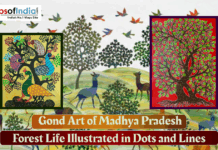Typography is the art of arranging letters and texts. It has advanced over centuries, from writing on palm leaves and communicating to using digital sources on computers or screens. The journey of typography shows how human communication and technology have grown together and enhanced communication.
Palm Leaves And Wooden Blocks
Earlier, people used palm leaves to write important texts because paper was not introduced/ invented. Palm leaves were carved with letters, and the ink was applied to make them readable, mainly for communicating important news and religious means. Meanwhile, wooden blocks were used for printing during the Tang Dynasty in China. Texts were carved onto these blocks, inked, and pressed onto paper to make copies, which made sharing knowledge faster and easier. Buddhist scriptures and a book, DIAMOND SUTRA, were printed by China through wooden block printing.
-
The Gutenberg Printing Press
In the 15th century, Johannes Gutenberg invented the printing press, which enhanced book production. His invention used movable metal type, allowing printers to arrange and reuse letters quickly. This made books cheaper and more widely available. This period of the 15th century was a sparking period of cultural and mental development.
Early typefaces were bold and angular, changing over time into serif fonts with small decorative strokes/lines at the ends of letters, enhancing readability and creative communication or texts.
-
The Rise Of Serifs And Sans Serifs
Serif fonts like Garamond and Times New Roman are used in printing for their formal appearance and readability. However, the Industrial Revolution in the 19th century brought a need for cleaners and modern fonts that people used for daily use. This led to the creation of sans serif fonts like Helvetica and Arial, which lacked the decorative lines or stokes of serifs but offered a simple, contemporary look suitable for advertising and signs.
Digital Typography
In the 20th century, they brought the biggest change to printing. Computers and digital technology enhanced typography. Designers have powerful tools to create and manipulate fonts digitally (change as per their needs).
Software like Adobe InDesign and Illustrator allow the changes and adjustments needed in font styles and sizes, opening up many possibilities in design.
Digital tools have enhanced and increased the use of typography:
- Platforms such as Adobe Fonts and Google Fonts provide extensive collections of fonts that designers, students, teachers, and anyone editing or writing content can easily access and use in their projects.
- Applications like Adobe Illustrator have tools for designing and refining fonts according to our needs, giving designers the opportunity to change typefaces for different types of work.
- These innovative fonts allow for changes or adjustments in weight, width, and other elements used in a single file, enhancing design flexibility and appreciating designers’ work.
- Web fonts and CSS ensure typography in digital platforms that enhances readability and visual appeal and grasps readers’ attention.
- Digital tools have made typography more accessible and versatile, helping designers innovate and collaborate on new fonts and styles worldwide.
From ancient methods of writing on palm leaves to the digital use of typography, this art form plays a crucial role in communicating and expressing ideas visually so that people understand them. As technology develops, typography is adopted by many people, giving them new challenges and opportunities, reflecting both shifts in culture and advancements in design. Digital tools have increased the possibilities of typography and enhanced a global community of designers dedicated to pushing the boundaries of typed design. Typography is human creativity and innovation, evolving with technology to meet modern communication and expression.




